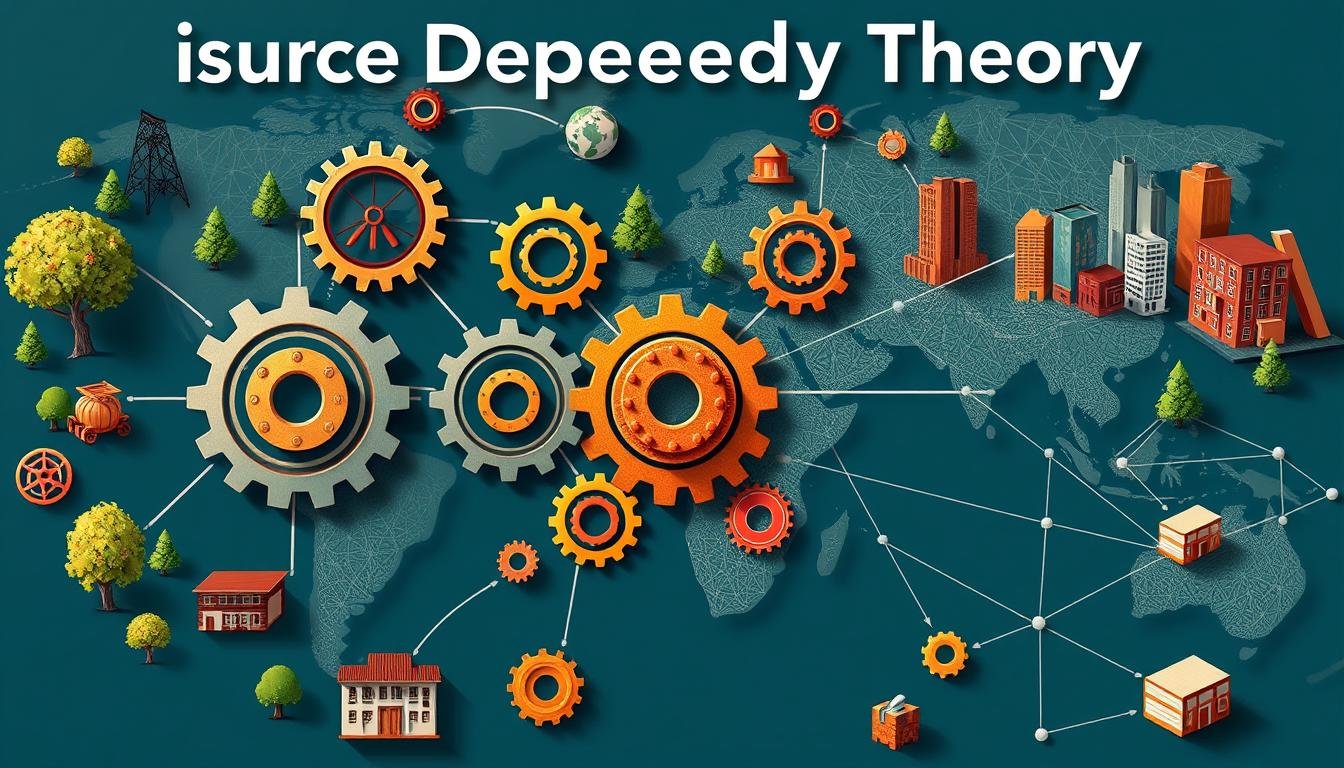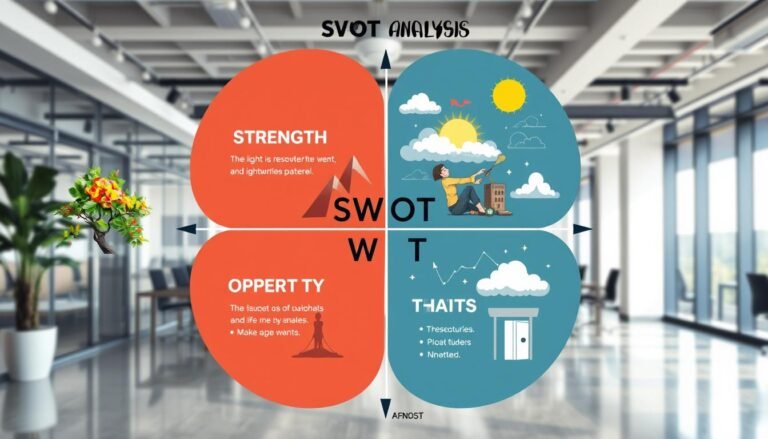Understanding Resource Dependency Theory Basics
Imagine if your organization’s survival depended on the relationships you make outside. This idea is at the core of Resource Dependency Theory (RDT). It shows how organizations must work with others to get the resources they need. Pfeffer and Salancik introduced this idea in 1978. They said that how well an organization can adapt and manage its dependencies is key to staying ahead.
As organizations rely more on each other and face more uncertainty, power becomes a big factor. This power often goes to those who have the most resources. We will look into the main ideas of RDT, how power affects things, and strategies for managing resources well.
Key Takeaways
- Organizations adapt strategies to mitigate dependencies with external actors.
- Power dynamics between organizations are influenced by resource control.
- Diversification and strategic alliances enhance bargaining power.
- The need for inter-organizational links increases with external uncertainties.
- Effective management aligns internal structures with external pressures.
Introduction to Resource Dependency Theory
Resource Dependency Theory (RDT) helps us understand how organizations work with outside resources. It shows that companies need things like money, information, and materials from outside. This theory is important for making strategies and managing relationships with other groups.
Companies often work with others to get better resources and lessen risks. Being dependent on outside resources means some companies can have a lot of power. This power affects how they work with others in their field.
This theory says knowing about resource dependencies is key for good management. Companies might merge or form alliances to lessen risks. They share resources to keep a balance of power. Jeffrey Pfeffer and Gerald R. Salancik introduced this idea in the late 1970s. It helps us see how outside factors shape how companies work and make decisions.
Understanding RDT shows how managing relationships with other groups can help a company do well. It helps companies use strategies to stay strong in a tough market. This way, they can handle unexpected problems better.
As companies see how important outside resources are, RDT helps us understand how businesses work together. It gives leaders insights on making choices for growth and staying strong.
Key Concepts of Resource Dependency Theory
Resource Dependency Theory helps us understand how organizations work with the outside world. It shows how being dependent on others affects their decisions and how they manage resources.
Organizational Dependence
Organizations need things from outside to survive. This need can change how they work and who has power. Pfeffer and Salancik (2003) say that organizations are tied down by their need for these outside resources. They can be weak if they depend too much on a few powerful groups.
External Dependencies and Critical Resources
Knowing about outside dependencies is key for companies in complex settings. Things like money, workers, and materials are crucial for success. New companies must be careful not to rely too much on a few big players.
This can lead to being taken advantage of. Yli-Renko et al. (2001) suggest that new companies can protect themselves with contracts and alliances. This helps them deal with the risks of depending on others.
| Key Aspect | Description |
|---|---|
| Organizational Dependence | Relying on external entities for essential resources. |
| External Dependencies | Interconnectedness with other organizations targeting resource acquisition. |
| Critical Resources | Vital resources necessary for operational success. |
| Risk Management Strategies | Using contracts and alliances to mitigate dependency risks. |
The Role of Power Dynamics in Resource Dependency
Power dynamics are key in understanding how organizations work together. They shape how groups make decisions and set their goals. This is very important for groups trying to do well in tough situations.
Power Relations Between Organizations
Power relations show how groups influence each other based on what they need. A group with lots of resources or money can tell others what to do. This makes one group more powerful than the other, making the weaker group follow its lead to get what it needs.
Mutual Dependencies and Strategic Interactions
Power and mutual dependencies create complex relationships among groups. Groups can’t just do things on their own; they need to work with others to get resources. Things like joining together, making deals, and finding new resources show how these relationships work. Groups also change to deal with outside pressures, showing they can be strong and creative.
| Strategy | Description | Impact on Dependency |
|---|---|---|
| Resource Diversification | Broadening resource sources to reduce reliance on a single entity. | Minimizes risk and enhances autonomy. |
| Alliances | Forming partnerships through mergers and collaborations. | Increases bargaining power and resource access. |
| Adaptive Compliance | Adjusting organizational practices in response to demands from powerful donors. | Ensures continued resource flow but may limit autonomy. |
| Vertical Integration | Controlling additional stages of production or resource supply. | Reduces external dependencies and enhances control. |
| Lobbying | Engaging in advocacy to influence policy and decision-makers. | Strengthens resource position and creates leverage. |
In summary, power dynamics greatly affect how groups handle their dependencies. Knowing about these relationships helps groups work better together. This leads to more stability and better use of resources in different situations.
Strategies for Managing Resource Dependencies
Organizations need to handle their resource dependencies well to grow and stay strong. They must use key strategies to control resources and lessen risks. These strategies help manage the risks of relying too much on certain resources.
Diversification of Resources
Diversifying is key in managing resource dependencies. By adding more suppliers or products, companies can depend less on one source. This reduces the risk of running out of resources. It also helps them stay strong when the market changes.
Formation of Strategic Alliances
Forming strategic alliances is another good strategy. Through partnerships, companies can share resources and expertise. This helps them stay competitive and access important resources better.
Enhancing Negotiation Power
Improving negotiation skills is also crucial. By getting better at negotiating, companies can get better deals. This helps them get the resources they need while keeping their independence.
Source Links
- Resource dependency theory | Definition & Facts
- Resource dependence theory
- Resource Dependence Theory
- Resource Dependency Theory – Vocab, Definition, and Must Know Facts | Fiveable
- No title found
- Resource based view and resource dependence theory in decision making process of public organisation – research fi ndings
- Resource dependency theory and entrepreneurship
- Resource dependency and strategy in healthcare organizations during a time of scarce resources: evidence from the metropolitan area of cologne
- RESOURCE DEPENDENCY THEORY EXPLAINED – Research Consult Uganda
- Resource Dependence Theory – TheoryHub – Academic theories reviews for research and T&L
- Resource dependence theory: How well does it explain behavior of organizations?
- Resource Dependence Theory
- Jenny Jan’s dilemma: applying the principles of resource dependence theory to vendor selection negotiations







